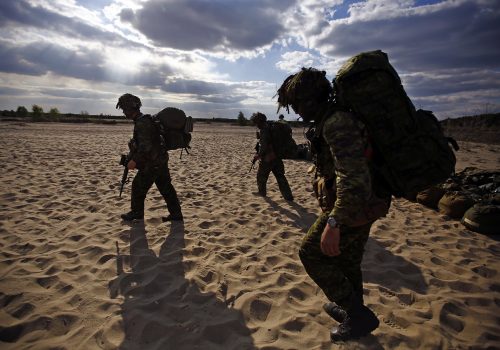China is a present danger to Europe. NATO’s defense plans must respond.

Good news: NATO’s Concept for the Deterrence and Defense of the Euro-Atlantic Area (DDA) may soon have the blessing of NATO-member leaders at this month’s summit in Brussels. But there’s bad news too: It is already time to update the DDA to address China.
In May 2019, the NATO Military Committee, made up of the allies’ defense chiefs, signed a new military strategy—the first such document written by NATO since the late 1960s. The Military Committee later introduced two subordinate documents that map how to implement the Alliance’s strategy, the first being the DDA. The DDA outlines how the Alliance will use its military power to address the primary threats confronting allied interests in Europe. It calls for employing the Alliance’s military power to deter and defend against its two major threats—Russia and international terrorism—across Europe and beyond in all domains. The second document, the NATO Warfighting Capstone Concept (NWCC), outlines a twenty-year vision for the Alliance’s warfare capabilities and characteristics. The DDA focuses on short-run threats, while the NWCC looks at the longer term. Together, these concepts should help NATO better align its existing tools, processes, and activities to ensure there’s greater coherence in how the Alliance secures and stabilizes the Euro-Atlantic region.
However, in not emphasizing threats from China along with Russia and international terrorism in the DDA, the Alliance comes up short. Some in Europe object to casting China more clearly as a threat. They argue China isn’t a military threat in Europe or that the threat isn’t manifest today, so NATO shouldn’t or doesn’t need to do much about it at the moment. Neither of these perspectives is grounded in reality. The evidence indicates China isn’t some challenge of tomorrow or threat that has yet to fully form; even today, it is a clear and present threat to allied security in Europe and beyond.
Some Chinese threats to European security are merely insidious. For example, China undermines Europe’s military capabilities by stealing defense-related intellectual property and sharing it with its own military and defense industry as China develops new weapons and capabilities. Similarly, Chinese investment in European infrastructure—especially shipping terminals, utilities, and telecommunications networks—provides an excellent platform for intelligence-gathering on NATO military operations. In a worst-case scenario, China could weaponize its ownership or operation of infrastructure in Europe to frustrate, limit, or prevent US or allied use.
In other cases, the Chinese threat to Europe manifests in the form of outright attacks. Chinese cyberattacks on European government, industry, military, academic, and civil institutions—including, reportedly, on hospitals during the pandemic—are relentless and massive. In 2014, NATO declared that cyberattacks could trigger the invocation of Article 5, the Alliance’s mutual-defense clause.
Subscribe for events and publications on transatlantic security
Sign up for updates from the Atlantic Council’s Transatlantic Security Initiative, covering the debate on the greatest security challenges facing the North Atlantic Alliance and its key partners.
More broadly, Chinese military threats to the global commons also impact Europe. As a percentage of its overall foreign trade, Europe has a higher share of its trade passing through the increasingly militarized South China Sea than the United States does. But until Europe wakes up to the risks of Chinese dominance there, as well as in other chokepoints and sea lanes from Djibouti to Malaysia, the United States should focus on how China affects European security closer to the continent itself. Critics will rightly point out that this is a Euro-centric approach, but in the short run, which the DDA is designed to address, focusing on Europe makes sense politically and practically. Politically, European decision-makers are more likely to act if the public perceives threats locally or regionally, as shown by increased defense spending since Russia’s 2014 invasion of Ukraine. Practically, it is easier for European governments and defense establishments to project power locally and regionally than into East Asia.
Some within NATO are already keeping an eye on China. For instance, the authors of the recently published NATO 2030 analysis argued that the Alliance must do more to adapt itself for great-power competition that includes China. However, the authors claimed China “is not, at present, a direct military threat to the Euro-Atlantic area.” This is demonstrably false.
Certainly, the threat from Russia—perceived as existential by some NATO allies—is first among equals when it comes to security challenges facing the Alliance. But China is a military threat to NATO today, as a consequence of its attacks on Alliance members in Europe and North America. The DDA must address it.
John R. Deni is a nonresident senior fellow in the Scowcroft Center for Strategy and Security’s Transatlantic Security Initiative at the Atlantic Council and a research professor of joint, interagency, intergovernmental, and multinational security studies at the US Army War College’s Strategic Studies Institute. He’s the author most recently of Coalition of the unWilling and unAble: European Realignment and the Future of American Geopolitics.
Further reading

The Transatlantic Security Initiative, in the Scowcroft Center for Strategy and Security, shapes and influences the debate on the greatest security challenges facing the North Atlantic Alliance and its key partners.
Image: British Army soldiers are joined by French and Danish troops as they take part in a training exercise to prepare them for their roles in NATOs Very High Readiness Joint Task Force. Photo by Owen Humphreys/PA Images via Reuters.


